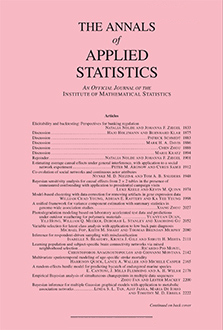Abstract
A small area estimation method is developed for repeatedly conducted multipurpose surveys. A multilevel time-series model is proposed that uses direct estimates for the most detailed domains observed at the highest frequency of the repeated survey. A consistent set of estimates at different aggregation levels is then derived by aggregation of the model-based predictions obtained for the most detailed domains observed at the highest frequency. The model borrows strength over time and space via smooth and local level trends at different aggregation levels. The model also borrows information from auxiliary series available from registers with coefficients that can vary over both domains and time. Regional domain random effects are allowed to vary smoothly over space according to a spatial autoregressive process. To account for the diversity of domains and for more volatile time-dependence, nonnormally distributed random effects and trend innovations are used via so-called global-local shrinkage priors. A Bayesian approach is taken, and the model is estimated by MCMC simulation. The method is illustrated with an application to the Dutch Labour Force Survey to produce monthly provincial and quarterly municipal unemployment figures.
Acknowledgments
The authors are grateful to the anonymous reviewers who provided useful and constructive comments on a former draft of this manuscript.
Citation
Harm Jan Boonstra. Jan van den Brakel. "Multilevel time-series models for small area estimation at different frequencies and domain levels." Ann. Appl. Stat. 16 (4) 2314 - 2338, December 2022. https://doi.org/10.1214/21-AOAS1592
Information





